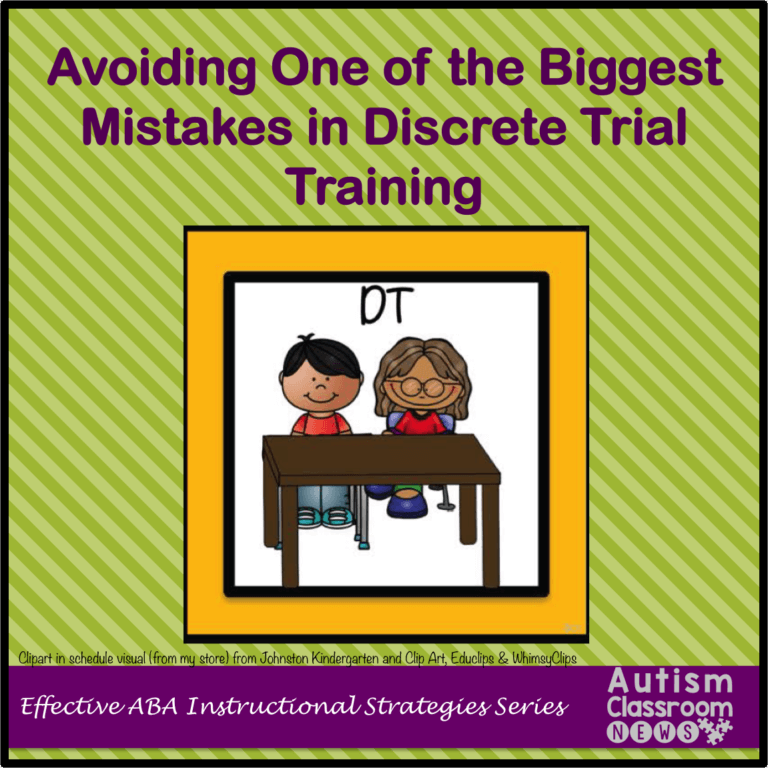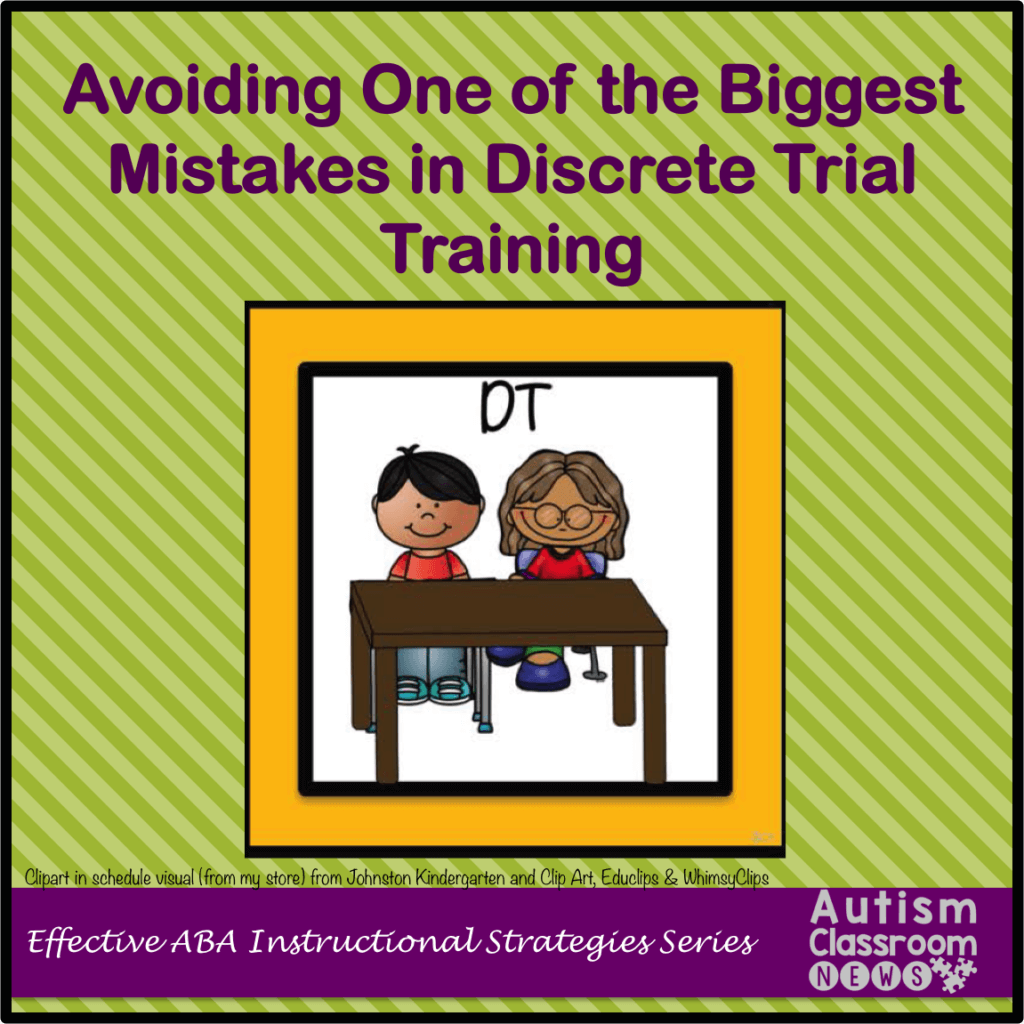Continuing in our discussion of discrete trials as an effective method of ABA instruction, I am going to dissect the different elements of discrete trials and share some best practices about each one as well as lessons I’ve learned over the years. This one may not be the BIGGEST mistake but it is one that I see most often and it undermines all your efforts.
One of the first steps in any good instruction is to lay out the steps that have to be taught and sequence them in the order you want to teach them. One of the elements that I often see people neglect in DTT is breaking down the skill that needs to be taught. There is a tendency to want to teach a whole goal or a whole skill as an all or nothing prospect. For instance, many times we want a student to complete a two-step direction. His goal on his IEP is that he will complete a 2-step direction given by the instructor on 9/10 opportunities (or something like that). There is a tendency to want to start the instruction with 2-step directions. So we present 2-step directions over and over and hope to reinforce when he happens to follow it. This strategy might work if someone has first taught him to follow a 1-step direction. If not, it’s unlikely he’s going to be successful with 2 steps. So, we need to break the skill down.
While this example seems kind of obvious, it’s not as obvious when we start with something like “Bill will read 20 sight words with 90% accuracy by May 2015.” Many times we start with all 20 sight words. We go through them every day. We follow all 6 steps of the discrete trial process, just waiting for him to get something right so we can reinforce his performance. We present our words, we prompt him and we reinforce him and his performance gets better but very, very slowly. And we wonder why he is such a slow learner (spoiler alert: Later in this series I’m going to be talking about what’s wrong with that thinking). Perhaps he’s not a slow learner….perhaps we are slowing him down. Instead of working on 20 words at a time, what if we started with 3. When he masters those 3, we’ll do 3 more. Then we’ll put all 6 together randomly and see if he can discriminate them. Then we’ll teach 3 more and then put all 9 together. We keep doing this until we get to 20–and of course we keep going even when he masters those because learning should never stop.
What we are doing is crucial to the DTT process….we are breaking the skill down and teaching it in small increments. This is a critical element of all types of instruction, not just DTT. But if you aren’t breaking the skill down into smaller parts and presenting them systematically, you are definitely not doing discrete trials–or at least you aren’t doing them well (or probably even effectively). You have to start with a systematic instruction program of the skill you want to teach and build up to it. It’s not that different than why we teach addition, then subtraction, then multiplication and division. We don’t try to teach all those math functions at the same time because the student wouldn’t be successful.
And here’s a news flash–yea I know it will be revelation–people who aren’t successful at learning something, don’t want to continue. And with many of our students, that’s when we get challenging behavior.
Some things to think about when developing or choosing DTT programs:
Size of the Steps
Use steps that are large enough to move forward but small enough that the student doesn’t get stuck. You’ll have to try some of them out to figure this out. Steps that are too big dead end the program. Steps that are too small take FOREVER for the student to learn. Some students can learn with bigger steps than others. Know your learner.
Sequence the Steps
Sequence the steps systematically and present them in order. I’ll talk about this some more when I talk about the steps of the discrete trial. We tend to think about teaching one item in isolation and teaching another in isolation then putting them together randomly. That’s one way to do it, but research (Grow & Leblanc, 2013) is showing us that it is more efficient in most cases to present three items/commands together at a time (e.g., horse, fish, bird for receptive vocabulary). When those three are mastered, present 3 more. Then put them together randomly. Then add 3 more, etc. I’ll talk more in depth about this in future posts.
Know the Prerequisites of the Skill
Sometimes the prerequisite (what needs to be mastered before this skill) is readily apparent. I need to master following 1-step directions before I teach 2-step directions. Sometimes it’s not as apparent (e.g., I need to know how to attend to materials and the instructor before I can complete discriminations among pictures). Know what the student needs to be able to do first.
Affiliate links included below.
Some curriculum come with programs already developed–it’s one of the things I like about the Strategies for Teaching based on Autism Research (STAR). The PEAK Relational Training System
also comes with programs readily made. Others, like the ABLLS®-R: The Assessment of Basic Language and Learning Skills-revised and the VB-MAPP: Verbal Behavior Milestones Assessment and Placement Program
don’t but often come with suggestions.
Other resources (that aren’t complete curricula) for programs include: A Work in Progress: Behavior Management Strategies &: A Curriculum for Intensive Behavioral Treatment of Autism and Behavioral Intervention for Young Children With Autism: A Manual for Parents and Professionals
. The shaping programs from the Murdoch Program Library are also excellent for teaching functional skills in DTT.
So, these are some resources for finding appropriate programs for instruction using DTT. The key point is that you have to break the skill down in order to teach it. That allows the student to be successful, come into contact with reinforcement with less prompting, and become more independent in mastering the full skill. Not breaking skills down is probably one of the most overlooked elements of DTT because people think that the trial itself is what makes it effective. Presenting a whole list of skills without teaching them in a meaningful way is just testing–it’s not teaching.
The next posts are going to focus more on the trial itself and the 6 elements that are important to include. What resources do you use for writing programs for instruction? Please share them in the comments.
Until next time,






![Summer resources to help survive the end of the year in special education [picture-interactive books with summer themes]](https://autismclassroomresources.com/wp-content/uploads/2018/05/SUMMER-RESOURCES-ROUNDUP-FEATURE-8528-768x768.jpg)

